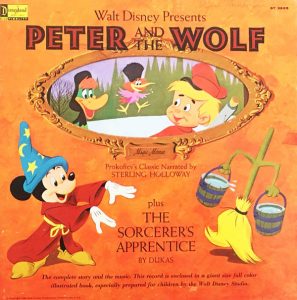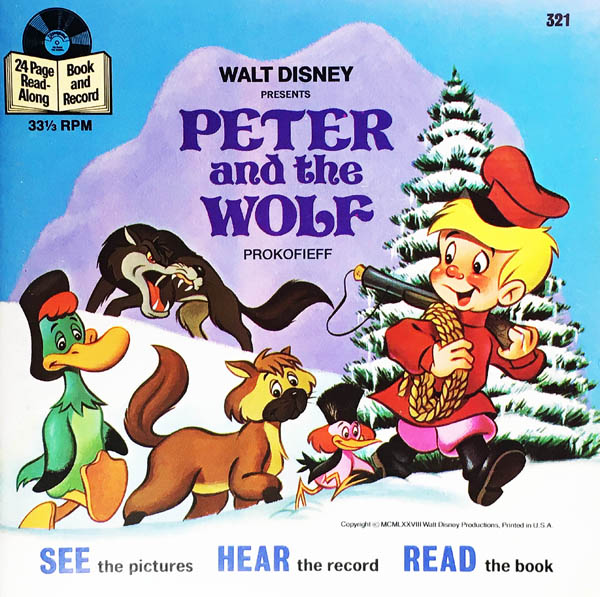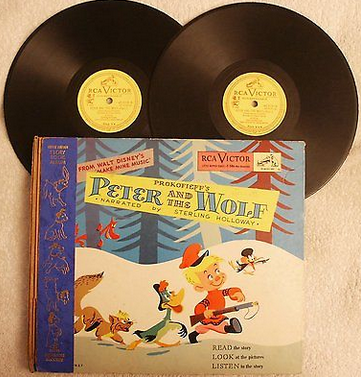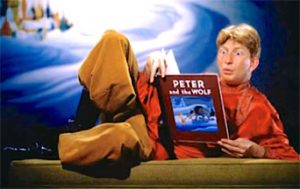Since we looked at The Sorcerer’s Apprentice in our last installment, let’s flip the Disneyland LP to Side One for Disney’s interpretation of a children’s musical classic.

Walt Disney Presents
PETER AND THE WOLF
Narrated by Sterling Holloway
Music by Sergei Prokofieff
Disneyland Records WDL-3016 (Side One Only / 12” 33 rpm / Mono)
LP Reissues: WDL-1016 (1960); DQ-1242 (1964); ST-3926 (1964, with Magic Mirror book); ST-3926 (1969, with regular Storyteller book)
CD Reissue: DQ-1242 (2004, Wonderland Music Company Music-on-Demand Theme Park Edition).
(All of the above are paired with The Sorcerer’s Apprentice)
CD Reissue: D-002066392 (2015, Bonus material on “Fantasia Legacy Collection” Set)
45 RPM Reissue: #605 (1978)
Originally Released April 3, 1958. Executive Producer: Jimmy Johnson. Album Producer: Camarata. Arranger: Edward Plumb. Conductor: Charles Wolcott. (From the 1946 Soundtrack of Make Mine Music. Running Time: 14 minutes.
When Walt Disney told 1957 television viewers that Sergei Prokofieff (or Prokofiev) visited his office and proudly performed his “Peter and the Wolf” composition, he was not telling tales. The meeting happened in 1938, the piano was the actual article, but the composer had passed before the episode was filmed, so pianist Ingolf Dahl played Prokofieff. This appeared on “The Fourth Anniversary Show” for the Disneyland TV series on ABC:
Peter and the Wolf was intended as a Fantasia segment, to be added later had the feature become an ongoing presentation with interchangeable sections. In the context of Fantasia, which had no dialogue in its animated sections, there might have been no narration at all—though Peter and the Wolf was written for narrator as well as orchestra. After tighter budgets and the pressures of WWII had affected studio and artistic operations, Peter and the Wolf became part of “A Fairy Tale in Music” for the first of the “package films” containing multiple animated segments: 1946’s Make Mine Music.
The traditional version usually runs between 20-25 minutes, allowing for many sections of musical themes and accents. For Make Mine Music, Peter and the Wolf was truncated to run under 15 minutes, with a great deal of visual action added out of necessity, this being an animated version, after all. As delightful as Sterling Holloway’s narration always is, it dominated the fast-paced segment.
 For the first time, all of the characters were given names. Each had some story “business” to do, which is astonishing for a film of this length—we even get an idea of the hunters ‘personalities in mere seconds. The technique works especially well for Sonya the duck, Ivan the cat and Sasha the little bird. There is an expression: “Never name barnyard animals,” the idea being you’ll become attached to them and never part with them. That principle works here because the apparent loss of Sonya, especially when coupled with her character design and animation (she reminds me a little of my Aunt Sadie) creates a strong attachment.
For the first time, all of the characters were given names. Each had some story “business” to do, which is astonishing for a film of this length—we even get an idea of the hunters ‘personalities in mere seconds. The technique works especially well for Sonya the duck, Ivan the cat and Sasha the little bird. There is an expression: “Never name barnyard animals,” the idea being you’ll become attached to them and never part with them. That principle works here because the apparent loss of Sonya, especially when coupled with her character design and animation (she reminds me a little of my Aunt Sadie) creates a strong attachment.
It’s worth noting in today’s delicate times that the Walt Disney of the 1940’s changed Peter’s bullet-filled rifle into a less dangerous toy pop gun when millions of kids still fired B-B’s. Sonya stays alive in Disney’s version, while the last line of the original is about her being swallowed, so there’s that. The music on the Disneyland Record is a pickup from the Make Mine Music film, as evidenced by the popping noises and other sound effects in the 1946 soundtrack. However, Holloway’s narration was rerecorded for the 1960 album.
Our colleague Leonard Maltin is not too crazy about the film’s narration (no reflection on Holloway’s performance). “It was designed to be heard, not seen,” he wrote of Peter and the Wolf in his indispensable landmark book, The Disney Films. Conceding it is possible to do visual justice to the piece and that the animation is pleasing, he feels the Disney staff went overboard with too many names and the narration, which he described as a “more up-to-date and pointed kind, with sportscaster overtones (‘Look out, Sasha!’)”.
 As a recording, the narration becomes a little more beneficial because the listener can imagine the action as well as enjoy the music. For those seeking the most accurate, authentic version of Peter and the Wolf—and there are plenty—Disney’s recording would be considered a very special exception rather they a definitive example of the modern classical masterwork.
As a recording, the narration becomes a little more beneficial because the listener can imagine the action as well as enjoy the music. For those seeking the most accurate, authentic version of Peter and the Wolf—and there are plenty—Disney’s recording would be considered a very special exception rather they a definitive example of the modern classical masterwork.
Most people were so familiar with the story and the music throughout the 20th century that one version or another was likely to have been acquired for a record collection, so the Disneyland vinyl releases were among the most steady sellers from the sixties to the eighties. The first version was a back-to-back LP with The Sorcerer’s Apprentice, which we discussed in our last Animation Spin. While that album was being repackaged several times with basically the same cover design, the record was also packaged with a full-color book in the Storyteller series, first with the die-cut “Magic Mirror” front cover, then with a standard cover.
There was no widely released domestic CD, but the Disney Theme Parks did make it available briefly through the on-demand “Wonderland Music Store” kiosk systems installed at various locations in 2004. When Fantasia received the deluxe Walt Disney Records Legacy Collection treatment, both sides were included as bonus tracks, and are available for download from iTunes.

Walt Disney Presents
PETER AND THE WOLF
Narrated by Robie Lester
Music by Sergei Prokofieff (Prokofiev)
Disneyland Book and Record LLP-321 (7” 33 rpm / Mono)
Released in October 1968. Executive Producer: Jimmy Johnson. Producer: Camarata. Running Time: 13 minutes.
Revised Reissue Released in 1978. Producer: Jymn Magon. Narrator: Hal Smith. Running Time: 9 minutes.
Producer Tutti Camarata broke with Disneyland Records tradition for this particular read-along version of Peter and the Wolf because of its musical nature. Except for this title, the entire original line of Disneyland “little LP” read-along records narrations did not use background music or sound effects from 1965 to 1977. Robie begins Peter and the Wolf immediately. She does not start with the usual “This is a Disneyland original little long-played record” and there are no signals from Tinker Bell and her little bells to turn the pages. For this time only, fully orchestrated music plays throughout her reading.
Roble Lester read this text in a little booth at Sunset Sound that is still there (probably with a stack of other scripts in a limited amount of time). It was later edited to fit the music track. This track did originate in Make Mine Music, but is an unidentified performance that was probably done in Berlin by the Symphonie Orchester Graunke, since this orchestra also played for the soundtracks of Walt Disney’s Sleeping Beauty, Grand Canyon and countless Disneyland and Buena Vista recordings in the fifties and sixties. A separate version was also produced for the U.K. that sounds like it was narrated by Tony Brandon, who headlined the Disneyland album, Misty the Mischievous Mermaid, a fascinating album you can discover here.
Ten years later, when Jymn Magon revised the read-alongs to have full casts, music and sound effects, Peter and the Wolf used the 1968 Camarata music track and replaced Robie Lester’s narration with Hal Smith. The editing in this rather brief version is a little more true to the original in that the themes and narration are more precisely timed and matched.
From Walt Disney’s MAKE MINE MUSIC
PETER AND THE WOLF
Narrated by Sterling Holloway
Music by Sergei Prokofieff
RCA Little Nipper Storybook Album WY-386 (Two 10” 78 rpm Records / Mono)
LP Reissues: RCA Camden CAL-1067 (Mono) CAS-1067 (Electronic Stereo) (1965)
RCA Victor AYL1-4450
(Side Two Only, with Walt Disney’s Pinocchio on Side One)
Originally Released in 1949. Writers: Dick Huemer, Cap Palmer. Arranger: Edward Plumb. Conductor: Charles Wolcott. Running Time: 13 minutes.

Because RCA Victor’s 78 RPM read-along album version of Peter and the Wolf was released only a few years after Make Mine Music was in theaters, the movie is mentioned on the package. It disappeared from subsequent recordings while Fantasia was still mentioned in the context of The Sorcerer’s Apprentice.
 Peter and the Wolf became a stand-alone cartoon in the mid-20th century when Make Mine Music faded into obscurity. This was true of several other segments like “Casey at the Bat” and “Johnny Fedora and Alice Blue Bonnet.” Make Mine Music was never reissued theatrically and received no TV airplay until the Disney Channel presented it in the ’80s. In the meantime, the Peter and the Wolf segment was seen practically everywhere, easily the most accessible segment of its “mother ship.”
Peter and the Wolf became a stand-alone cartoon in the mid-20th century when Make Mine Music faded into obscurity. This was true of several other segments like “Casey at the Bat” and “Johnny Fedora and Alice Blue Bonnet.” Make Mine Music was never reissued theatrically and received no TV airplay until the Disney Channel presented it in the ’80s. In the meantime, the Peter and the Wolf segment was seen practically everywhere, easily the most accessible segment of its “mother ship.”
RCA recreated both Sterling Holloway’s narration and the music assisted by Disney creatives. It’s virtually note-for-note and word-for-word from the film, courtesy Edward Plumb and Charles Wolcott, who adapted the score for the four sides needed to make up this two-record set. This RCA and the Disneyland LP are almost identical but some of Holloway’s comments, the handful of sound effects and a few musical phrases differ here and there.


 GREG EHRBAR is a freelance writer/producer for television, advertising, books, theme parks and stage. Greg has worked on content for such studios as Disney, Warner and Universal, with some of Hollywood’s biggest stars. His numerous books include Mouse Tracks: The Story of Walt Disney Records (with Tim Hollis). Visit
GREG EHRBAR is a freelance writer/producer for television, advertising, books, theme parks and stage. Greg has worked on content for such studios as Disney, Warner and Universal, with some of Hollywood’s biggest stars. His numerous books include Mouse Tracks: The Story of Walt Disney Records (with Tim Hollis). Visit 





















































I don’t know if it’s true or not, but it’s been written in several places that when Prokofiev viewed the finished Disney version of “Peter and the Wolf” he wept–but they weren’t tears of joy. This is intended, I suppose, as criticism of Disney’s visual interpretation. Yet it seems to me that Disney did justice to the composition through the animation. My difficulty with PW is with the story itself–it’s too short for us really to know the characters or care about them. No one is fleshed out or developed sufficiently to work up much sense of urgency. It seems to be a foregone conclusion that Peter will “get” the wolf, which essentially takes away any suspense. One commiserates with the friends on the supposed loss of Sonya–but even that is negated when Sonya appears alive and unharmed at the very end. But by focusing so much on the loss of Sonya it seems to overshadow Peter’s victory in capturing the wolf. So emotionally, it is not as satisfying as its flipside counterpart “The Sorcerer’s Apprentice”. But it is still a charming piece, and it seems Disney did not do a bad job of animating it. I have all three versions–Sterling’s narration, Robie’s narration, and Hal’s narration. It’s a good thing that Disneyland Records suspended their rule of not having underscoring for the Read-a-longs when Robie recorded the story of PW–it works best with the music and story presented at the same time.
Coincidentally, just before you started posting on these recordings of PW and SA, I was getting somewhat nostalgic for these specific pieces. I have since had a good listen to each of the recordings, so they are very fresh in my mind. Thanks for posting these last two highly informative articles.
I must be psychic — I just watched this cartoon earlier today, for the first time in years!
Like so many other children, I was introduced to the instruments of the orchestra by “Peter and the Wolf”. My parents had an old recording of it narrated, rather badly, by Eleanor Roosevelt. In the introduction she said that the grandfather was represented by the “BASS-oon”. Apparently no one in the studio had the temerity to correct the First Lady’s pronunciation.
I remember seeing that Disneyland segment, and at the time I thought it was Prokofiev himself playing the piano; Ingolf Dahl resembled him very closely. Dahl was an accomplished composer himself, and can be heard playing piano and other keyboard instruments in many film and television scores; for example, he played the second movement of Beethoven’s Pathetique Sonata in “A Boy Named Charlie Brown”.
Soyuzmultfilm made two stop-motion animated versions of P&tW, in 1958 and 1976. They’re both very good, though I think the latter suffers from its minimalist set designs. Spoiler alert: As in “Make Mine Music”, the duck survives in both versions — but in the earlier one, the wolf eats the cat!
Leonard Maltin is right when he says that P&tW “was designed to be heard, not seen.” Prokofiev wanted the story and the music to stimulate children’s imaginations, and he resisted any attempts to add a visual component. By 1946 he was back in the USSR for good, and he probably never saw Disney’s take on his work. Today, however, the story is so familiar that practically every live performance of it contains some visual or satirical element, or an original angle. I was in one performance called “Peter and the Croc”, told in Aussie ocker slang with a cast of Australian animals. Another was narrated by a well-known radio personality who adapted it to the characters he voiced on his show. When I was around nineteen or twenty and playing in my first professional orchestra, we did a ballet version of it, and I’ll never forget all those beautiful girls (they were all girls, even Peter and Grandfather) in tights going through their moves on stage at the dress rehearsal before donning their costumes for the performance. The wolf was over six feet tall, with legs that made Cyd Charisse look like an achondroplastic dwarf. Thus young people continue to find inspiration and uplift through exposure to the fine arts.
My introduction to this piece and story came from the Captain Kangaroo version; I’d heard that there was a David Bowie version, but I’d never found it. Now, since I was introduced to the dazzling beauty of the classic MGM cartoon before I was introduced to that of Walt Disney, my imagined visual when I listened to the Captain Kangaroo recording, I saw the story in my head as if it were one of those cartoons directed by Hugh Harman. Wow, imagine what that might have been like. We all know how lavish “THE BLUE DANUBE” (1939) was. It is actually a shame that the story wasn’t featured as part of “FANTASIA”, because it might have been a real challenge to tell the story through pantomime, rather than have intrusive narration, right down to the darker aspects of the story.
Captain Kangaroo for me too.
Now, I envision the Disney animated characters when ever I listen or play the music in my head.
Nobody does wolves like Disney.
I had The Original 78 release as a tot in the mid-50s, and played it to death. The music was affecting, the wolf was scary AF, and I was completely perplexed with this character who was Sterling Holloway. The perplexity didn’t diminish when I saw him later in an episode or two of The Twilight Zone.
All my kids records are long gone of course. I had the Bowie LP, and it was really good, but I ditched all my vinyl 20 years ago. Need a digital replacement.
And I really should snag a Make Mine Music / Melody Time DVD one of these days.
So many items on the to-do list…
D’OH! I was also reminded that Bowie was also not the first musical performer to have the honor of narrating P&tW.. That honor goes to Danny Kaye in a very memorable performance.
Three years later, you are the only mention I can find of that album on my 2nd Google attempt. That Danny Kaye version is STILL in my head (and I don’t mind.) I keep hearing “pah ro pah ro pah ro cock pook eh?” LOL
That “Peter and the Wolf” read-along adaptation sure was unique out of all the “old-style” Disney book-and-audio read-alongs, so much that for “Make Mine Music”‘s 70th anniversary I had the Big Bad Wolf review it in a vlog…
https://www.youtube.com/watch?v=l1OlAQOGpEY
I had that same two-sided, two-story record, too! Everytime I see or hear the name “Sasha”, TW’s duck comes to mind…
And, yes, it IS designed to be heard, not seen… just finished Robie’s read-along, enjoyed it!
I still own my 1949 78 rpm set. I will never part with it!
I’ve got the DQ-1242 ’64 edition in my library, along with Allan Sherman’s inspired lampoon, “Peter and the Commissar”… 😀
I still have the late 1940s 78rpm “unbreakable” recordings I got when I was a wee youngster back in the early to middle – 60s. I don’t where my dad got them, but they might still have been in bins at old record stores back then. I can clearly recall Sterling Holloway telling “me” to flip the record over, or ask if I was listening intently. Wonderful stuff. The recordings are probably very scratchy – I played them a lot when I was little – but I wouldn’t part with them for anything!
Even tho it’s a kids story, I just can’t see how a little child can even for a second, hold a wolf at bay with his rope – let alone tie him up.